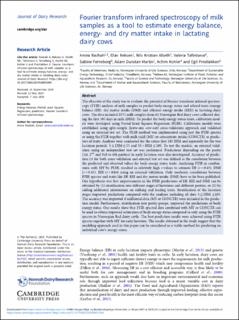| dc.contributor.author | Rachah, Amira | |
| dc.contributor.author | Reksen, Olav | |
| dc.contributor.author | Afseth, Nils Kristian | |
| dc.contributor.author | Tafintseva, Valeria | |
| dc.contributor.author | Ferneborg, Sabine | |
| dc.contributor.author | Martin, Adam Dunstan | |
| dc.contributor.author | Kohler, Achim | |
| dc.contributor.author | Prestløkken, Egil | |
| dc.date.accessioned | 2023-08-17T14:01:01Z | |
| dc.date.available | 2023-08-17T14:01:01Z | |
| dc.date.created | 2020-12-03T15:14:41Z | |
| dc.date.issued | 2020 | |
| dc.identifier.issn | 0022-0299 | |
| dc.identifier.uri | https://hdl.handle.net/11250/3084643 | |
| dc.description | This is an Open Access article, distributed under the terms of the Creative Commons Attribution licence (http://creativecommons.org/licenses/by/4.0/), which permits unrestricted re-use, distribution, and reproduction in any medium, provided the original work is properly cited. | en_US |
| dc.description.abstract | The objective of the study was to evaluate the potential of Fourier transform infrared spectroscopy (FTIR) analysis of milk samples to predict body energy status and related traits (energy balance (EB), dry matter intake (DMI) and efficient energy intake (EEI)) in lactating dairy cows. The data included 2371 milk samples from 63 Norwegian Red dairy cows collected during the first 105 days in milk (DIM). To predict the body energy status traits, calibration models were developed using Partial Least Squares Regression (PLSR). Calibration models were established using split-sample (leave-one cow-out) cross-validation approach and validated using an external test set. The PLSR method was implemented using just the FTIR spectra or using the FTIR together with milk yield (MY) or concentrate intake (CONCTR) as predictors of traits. Analyses were conducted for the entire first 105 DIM and separately for the two lactation periods: 5 ≤ DIM ≤ 55 and 55 < DIM ≤ 105. To test the models, an external validation using an independent test set was performed. Predictions depending on the parity (1st, 2nd and 3rd-to 6th parities) in early lactation were also investigated. Accuracy of prediction (r) for both cross-validation and external test set was defined as the correlation between the predicted and observed values for body energy status traits. Analyzing FTIR in combination with MY by PLSR, resulted in relatively high r-values to estimate EB (r = 0.63), DMI (r = 0.83), EEI (r = 0.84) using an external validation. Only moderate correlations between FTIR spectra and traits like EB, EEI and dry matter intake (DMI) have so far been published. Our hypothesis was that improvements in the FTIR predictions of EB, EEI and DMI can be obtained by (1) stratification into different stages of lactations and different parities, or (2) by adding additional information on milking and feeding traits. Stratification of the lactation stages improved predictions compared with the analyses including all data 5 ≤ DIM ≤105. The accuracy was improved if additional data (MY or CONCTR) were included in the prediction model. Furthermore, stratification into parity groups, improved the predictions of body energy status. Our results show that FTIR spectral data combined with MY or CONCTR can be used to obtain improved estimation of body energy status compared to only using the FTIR spectra in Norwegian Red dairy cattle. The best prediction results were achieved using FTIR spectra together with MY for early lactation. The results obtained in the study suggest that the modeling approach used in this paper can be considered as a viable method for predicting an individual cow's energy status. | en_US |
| dc.language.iso | eng | en_US |
| dc.publisher | Cambridge University Press | en_US |
| dc.rights | Navngivelse 4.0 Internasjonal | * |
| dc.rights.uri | http://creativecommons.org/licenses/by/4.0/deed.no | * |
| dc.title | Fourier transform infrared spectral data as a tool to predict energy balance, energy- and dry matter intake in lactating dairy cows | en_US |
| dc.type | Peer reviewed | en_US |
| dc.type | Journal article | en_US |
| dc.description.version | publishedVersion | en_US |
| dc.rights.holder | Copyright © The Author(s), 2020. Published by Cambridge University Press on behalf of Hannah Dairy Research Foundation | en_US |
| dc.source.pagenumber | 436-443 | en_US |
| dc.source.volume | 87 | en_US |
| dc.source.journal | Journal of Dairy Research | en_US |
| dc.source.issue | 4 | en_US |
| dc.identifier.doi | 10.1017/S0022029920001004 | |
| dc.identifier.cristin | 1855905 | |
| dc.relation.project | Norges forskningsråd: 244231 | en_US |
| dc.relation.project | Norges forskningsråd: 262308 | en_US |
| dc.relation.project | Nofima AS: 11311 | en_US |
| dc.relation.project | Nofima AS: 201702 | en_US |
| cristin.ispublished | true | |
| cristin.fulltext | original | |
| cristin.qualitycode | 1 | |

